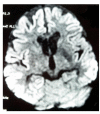Creutzfeldt-Jacob Disease: a case report
- PMID: 18782431
- PMCID: PMC2547099
- DOI: 10.1186/1757-1626-1-146
Creutzfeldt-Jacob Disease: a case report
Abstract
Introduction: Creutzfeldt-Jacob Disease is the most frequently seen type of prion diseases. Its clinical findings consist of predominantly progressive dementia with a rapid onset, myoclonus, and also cerebellar, pyramidal, extrapyramidal and visual signs. Definitive diagnosis is established with histological examination of brain biopsy or autopsy materials. Occurrence of periodical spikes in EEG, observation of cortical signal alterations during diffusion weighted (DW) MRI studies, and detection of protein 14-3-3 in cerebrospinal fluid (CSF) substantiate the diagnosis.
Case presentation: Seventy year-old male patient referred with complaints of weakness and involuntary movements in left arm, changes in behavior, and forgetfulness. He also developed akinetic mutism after nearly three months. In EEG periodic triphasic waves were seen. Despite the absence of any apparent pathological finding in T2 and FLAIR MRI, excluding signs of atrophy, on DW MRI hyperintense signal changes in cortical regions (cortical ribboning) were observed. Protein 14-3-3 in CSF was detected.
Conclusion: Patients who have progressive dementia and associated atypical features should be investigated especially with DW MRI. Cortical ribboning is a very useful diagnostic sign for CJD.
Figures
References
-
- Zerr I, Pocchiari M, Collins S, et al. Analysis of EEG and CSF 14-3-3 proteins as aids to the diagnosis of Creutzfeldt-Jakob disease. Neurology. 2000;55:811–15. - PubMed
LinkOut - more resources
Full Text Sources


